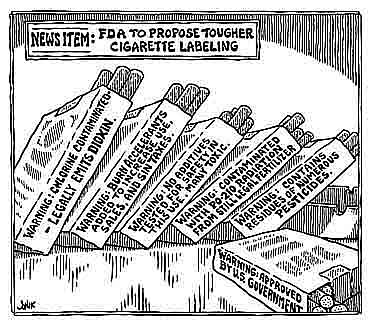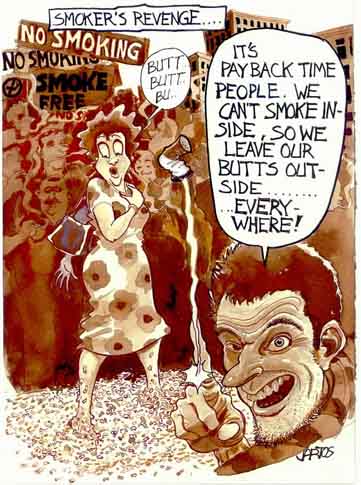|
Cartoons of
Dan McConnell
featuring
Tiny the Worm
Cartoons of
David Logan
The People's Comic
Cartoons of
John Jonik
Inking Truth to Power
|
Support the WA Free Press. Community journalism needs your readership and support. Please subscribe and/or donate.
posted Aug 28, 2009

If cigarette labels were honest, smokers would probably be growing their own tobacco.
cartoon by John Jonik
Ten Reasons Why FDA Cigarette Regulation is Bad News
Where are pesticide activists on the safety issue?
by John Jonik
Editor’s note:
The author, John Jonik, has been a pioneer in revealing how cigarette
regulation unfoundedly blames tobacco, rather than chemical adulterants,
for the ill effects of most commercially sold cigarettes. Now, the FDA,
with support from president Obama, is poised to undertake much stronger
regulation of cigarettes, leading possibly to a prohibition. According
to Jonik, the real culprits, the chemical companies, would escape unharmed.
We have to wonder if Congress or
president Obama read the recently enacted wholesome-sounding Food and
Drug Administration (FDA) bill to “regulate tobacco,” and whether
they considered its consequences. If they knew what they were
doing, that has troubling implications regarding the nation’s vital
scientific, health, and regulatory system.
1) This law will make typical cigarettes more dangerous: FDA is empowered to lower nicotine levels to make all cigarettes “light,” a long-used cigarette industry trick which creates more smoking (and more sales and “sin” taxes), deeper inhaling, and more exposures to many non-tobacco toxins and cancer-causing substances.
2) It retains the worst past and present harms: The FDA is required to ignore the 450 or so registered tobacco pesticides (chlorine, organophosphate, carbamate, etc.) and the extremely harmful residues they deposit on tobacco and in unwitting smokers’ lungs. It is also forbidden to address the phosphate fertilizers that contaminate typical products with carcinogenic PO-210 radiation. The bill considers these as “farm” issues to be left to the USDA, which has long approved those substances.
3) It ignores and will remove nicotine benefits, and threatens prohibition: The FDA, a drug agency, ignores the medicinal drug effects of nicotine for stress relief, alertness, digestive relief, appetite suppression and symptomatic relief for Alzheimer’s, Parkinson’s, and other pathologies. It ignores that those benefits are produced in spite of hosts of government-approved industrial toxic and cancer-causing contaminants inside of typical cigarettes. This bill will leave uninformed, insufficiently-warned smokers with the worst, most deadly contaminants—pesticides, dioxins, and PO-210 radiation—while virtually eradicating the beneficial components. This threatens that, in the future, the FDA will find “no medicinal value in tobacco” (because the FDA removed those values itself), and will find “significant harms” (because the FDA tolerated those avoidable harms itself), and will call for outright Prohibition.
4) False claims: The bill wrongly and absurdly describes nicotine as “harmful”. It is not. Even the FDA deems it safe in many nicotine-delivery products. The law claims that “tobacco kills” though most cigarettes are in fact industrially-contaminated products that are not even examined to affirm that they contain tobacco, and even though tobacco itself has by itself not yet been studied for harms.
5) Use of colloquial and marketing terms: The FDA accepts the cigarette industry’s deceptive term for itself, “tobacco companies”, as if the products are automatically just tobacco, or tobacco at all in some cases. Cigarettes, though they may appear to be stuffed with shreds of tobacco, though they contain nicotine and are made by “tobacco companies”, are not required to contain any tobacco at all—unless their voluntary labeling says so. Many labels say nothing one way or the other. “Tobacco” is also often processed out of the waste parts of the tobacco plant (stems, roots, dust, etc.) rather than the more valuable leaves. After processing and extensive adulteration, it is absurd, deceitful, widely confusing, unscientific, fraudulent and liability-dodging to maintain the name of the base material. A typical newspaper, ultimately from tree pulp, is no more a pine tree than a typical cigarette is tobacco.
6) Though the law is about tobacco, no evidence is cited about harms or benefits of tobacco itself: “Tobacco control” is the cover-girl, so to speak, of this legislation, but no studies of tobacco itself—without adulterants or contaminants—have been presented to justify any unqualified claims about tobacco causing deaths or diseases. The FDA bill accepts studies about highly contaminated cigarettes that ignore those contaminants, and then concludes that tobacco is the villain. This is like blaming a car for a drive-by shooting, rather than the occupants and their guns.
7) Serious child harms ignored, and allowed: The bill ignores dioxin which, in cigarette smoke, comes from still-legal use of chlorine tobacco pesticides and chlorine-bleached cigarette paper. Dioxins do not come from tobacco or any plant. Dioxins in smoke from typical cigarettes come from any of the many added non-tobacco crop products. They are especially harmful to young people, fetuses, pregnant women, and cause damage to sperm. The FDA’s “solution” is to get unwitting, unprotected victims, be they young people or mothers or fathers or anyone, to “just say no,” to seek what it calls “cessation.” Big Chlorine may be the biggest and worst member of the corporatocracy’s “too-big-to-fail” community.
8) Medical Science ignored: The legislation ignores that many if not most so-called “smoking related” diseases are impossible to be caused by smoke from any plant, but that most or all of those diseases are known effects of exposures to pesticides and dioxins. The FDA ignores the evidence of Agent Orange, Love Canal, Times Beach and other chlorine-dioxin calamities. Even worse, the FDA does not prohibit chlorine interests, or chemical and pharmaceutical makers of tobacco pesticides, or their insurers and investors, from participating in “tobacco” regulatory committees.
9) First Amendment problems: The bill makes it virtually impossible for alternative cigarette makers to exercise speech rights to truthfully communicate that their cigarette is organic or additive free—or free of pesticides, free of radiation, free of burn accelerants, or free of chlorine adulterants. To the FDA, to do so would suggest that products had “reduced risk.” The FDA does not acknowledge that such products would be automatically, by definition, reduced risk. One would have to spend unaffordable fortunes to prove the negative: that the products are less harmful. The bill does not require labeling that says, for example, “Warning: Maximized and inevitable risk and harm due to FDA-approved pesticide, chlorine, radiation and burn accelerant contamination.” Without such a warning, complicit parties in this cigarette cartel are duly saved from PR disasters, liabilities, and prosecution.
10) It creates crime escalation:
The bill acknowledges that it will create prohibition-style crimes of
illicit trade and smuggling and so forth. The bill incredibly says
that this trade will even support “terrorism.” Smokers, apparently,
un-patriotically, threaten some future 9/11. The law will require
cigarette makers to pay millions of dollars for the regulatory program,
but it does not forbid the firms from simply passing costs to their
customers: their victims. This will raise prices and the value
of cigarettes to illicit traders, including those endlessly-useful “terrorists,”
and will escalate crimes of theft and smuggling. The law itself
will create funding for the very “terrorists” that we are to dread. Bad
laws often cause more crimes and harms than they prevent, as we know
from 62 years of Reefer Madness laws aimed at that other smokable and
medicinal public-domain natural plant (and it’s non-smokable cousin,
hemp).
A solution is available, but it is so far off-the-table of our corporate-controlled government and media that it is invisible to the naked eye. Sensible, justifiable, socially-beneficial law would not impose costly and socially-disruptive regulations and burdens on millions of people, including non-complicit bars, restaurants and other businesses, or on continually-harassed sovereign Indian lands.
It would simply prohibit the relatively few cigarette manufacturers from contaminating smoking products with untested and known-harmful non-tobacco components. That radical idea would instantly spread to foreign lands.
This simple tactic would cut tobacco use, make cigarettes less appealing
to young people, reduce risk of fires (because artificial burn accelerants
would not be used), eliminate harms from pesticides and dioxins and
radiation, remove justification for many of the smoking bans and regressive
taxes, open up a long-overdue flood of civil suits against the chlorine-drenched
cigarette cartel (including ingredient suppliers), inspire public demand
to remove private industry influence from public governing, and even—ideally—lead
to publicly subsidized replacement of pesticide-intensive tobacco farms
with organic tobacco farms—right next to re-legalized hemp farms,
perhaps. Even wildlife would benefit. And peace-pipes would
be again legal in public places.
People have until Sept. 29, 2009 to submit Public Comments on the FDA’s “tobacco regulation” law. Go to the following website to comment, paying attention to all the requirements. There are links to see the whole law. You have to see it to believe it. Mainstream media have not been informative about this. Trust the mainstream version at your, and everyone’s, peril.
The comments website can be found by going to http://www.fda.gov/TobaccoProducts/ucm171216.htm. In the "organization" field you can list "n/a" or "individual"

Could this be the real reason the FDA is poised to ban cigarettes?
cartoon by George Jartos


